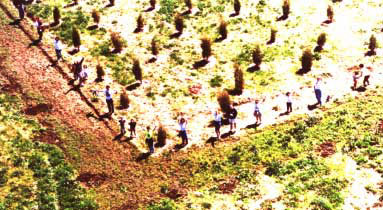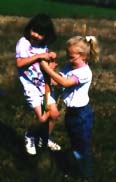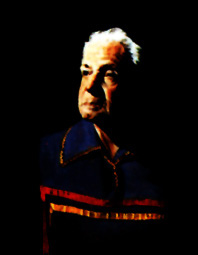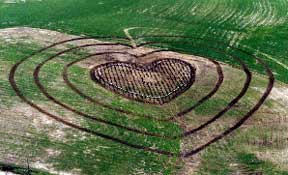|
Dr. Muller, who had recently retired as Under-Secretary General of the United Nations and taken on the post of Chancellor for the University for Peace in Costa Rica, had returned as the keynote speaker for the second event. The day before the celebration a breakfast was held with civic leaders where two other visitors to Kansas City were in attendance, Iroquois Chief Leon Shenandoah and Mohawk Chief Jake Swamp. After Dr. Muller had given his remarks at the breakfast both Chief Shenandoah and Chief Swamp shared their feelings about Kansas City and the heart of the country. The next morning, at the early morning celebration, Dr. Muller proposed a heart shaped avenue of trees be planted around the city, large enough to be seen from space, as a way for Kansas City to proclaim itself as loving the world with ‘a global heart.’ Considering the scope of such a project, involving land in two states and five counties: Jackson, Clay and Platte in Missouri, Wyandotte and Johnson in Kansas, as well as countless individuals, no serious discussion took place at the time. But the idea just wouldn’t go away. Through discussions with interested individuals the idea evolved into a heart shaped forest located somewhere in proximity to KCI, and that starting planting in celebration of the 20th Anniversary of Earth Day would be perfect timing. As it happened a task force was being set up by the Kansas City Chapter of the American Institute of Architects (AIA/KC) to make plans for the chapter’s centennial celebration. The mission of the task force was “...to establish a long-term educational focus on the future of our environment, both built and natural, in the Kansas City community...to convey our values to future generations and provide a legacy for the next 100 years.” The president of The Future Is Now board, architect Bob Berkebile (InContext article), took the idea to task force member and architect Rick McDermott. Rick remembers the meeting. "According to my calendar, I met with Bob on January 19, 1990 at his office. He outlined his concept of the project and asked if I would get involved in a leadership position. My response was that I thought it was a fabulous idea, and that I would begin forming a committee to tackle the project, and that I thought we could have something done in about a year. As I recall, at this point, Bob indicated that perhaps I didn’t understand that Phase I of the Heart Forest, which involved everything up to and including the initial planting, needed to be completed by Earth Week 1990...which was April 22-28, 1990." A member of Berkebile’s staff, David Murrell, was volunteered to assist McDermott, and they were joined by Paul Zumwalt, a landscape architect, and Jerry Monterastelli, Urban Forester with the Missouri Department of Conservation. Zumwalt presented designs to take advantage of the varying colors, heights, textures, and shapes of different plant materials that might naturally be found in a forest, but arranged formally in a way that would accentuate the heart shape with a focus on materials whose colors and textures would attractively change with the seasons. With a plan of five concentric heart-shaped rings surrounding an evergreen core settled on and plant selection underway, attention focused on where the Heart Forest would be located. Researching specific sites located near or on the airport property that would be adaptable to the project also involved Herb Gile, the Airport General Manager with the KC Aviation Department, and Stan Herd, land artist from Lawrence, Kansas. The first sites viewed had serious drawbacks. They either conflicted with the airport master plan, were too hilly, were inaccessible or just didn’t relate meaningfully to the runways. Finally a general location was selected because the two major runways formed an arrow that pointed in the direction only to find out the land was leased to a local farmer. The Aviation Department couldn’t get involved in any renegotiation of that lease but Gile indicated if the committee wanted to approach the farmer independently, he would have no objection. So on March 29, McDermott, Berkebile and Herd met with Charlie Peterson and his son Steve at the proposed site. Second and third generation farmers, whose family had farmed in the area since before the turn of the century, the Petersons listened to the story surrounding the genesis of the Heart Forest concept, its intended prupose and the request for the used of their leased property.
With the Peterson’s enthusastic support of the project the Aviation Department agreed to lease 22 acres to the Heart Forest Foundation on April 2nd, a source of 550 eastern red cedars that could be delivered by the planting date was located in Pennsylvania, the seedlings for the concentric band promised from the Missouri Department of Conservation, and by April 11 Stan Herd was plowing heart shaped concentric band in the rich Missouri soil with the Peterson’s equipment. Now with the design selected, the plant material ordered and the location set, two more things had to happen: sufficient labor to plant the trees and money. The decision was made to raise funds by adopting the center eastern redcedars for $100 each. This ‘heart of the heart’ would be a grid on a letter/number system. This would allow contributors to specify where they would want to plant a tree and locate it later to show their children and grandchildren. However the reality of the situation was that the money was not there for a fundraising campaign or publicity so the committee had to rely on the media and word of mouth. The task was made easier by the excitement generated by an idea of a forest that would be almost twice as large as the St. Louis Arch, that had the potential of being seen by everyone flying in and out of KCI, and that would stand for generations as the symbol of Kansas City’s commitment to a spirit of environmental and community rejuvention. As the planting date grew closer, more and more contributions flowed in and volunteers promised to show up to plant the 550 eastern red cedars and 200 hardwoods that would make up the central grove and first concentric band. T-shirts were sold and literature handed out at the Earth Day celebration in Theis Memorial Park on the 22nd, and the media planned to conduct interviews at the site the day before the planting. Then the rain storms rolled through on Thursday and Friday, leaving everyone with their fingers crossed for sun on the 28th and for the volunteers to show up.
April 28th dawned bright and clear, with a crisp breeze and a forecast for the 70s, a real BYOS (bring your own shovel) Day. With only half the cedars on site and a fly over for an aerial photo at 1 pm, timing was turning out to be everything. The 200 volunteers set to work planting and digging the holes; the second shipment had arrived at noon and by 12:45 all the cedars were planted; by mid-afternoon 2000 seedlings were in the first rows of the hardwood bands!
|
|
Fast forward to Now (2004)On our 11th planting day was April 29, 02000 when we planted out to the furthest bands. Now our task is to replant trees that don’t survive due to either the deer and/or rabbits, too wet or too dry conditions, stave off insects without using insecticides and keeping the weeds down without using herbicides until the trees are tall enough to shade the weeds out naturally. We are planning for a path to the center of the heart, a shelter, and solar powered night lighting for the perimeter of the heart, along with improvements to the parking area. Due to the relatively isolated location of the forest our parking lot seems to be a place for dumping of trash which also keeps us busy cleaning up. The summer of 2002 we also installed a drainage system in the upper right quatrant of the cedars. The geology of the site made a layer of clay very close to the surface which trapped water. Since cedars don't like “wet feet” this drainage system with improve the health of the cedar trees in this area. Each year we recommit to the Heart Forest as a symbol of rejuvenation from the Heartland. We continue to take encouragement from the quote of Margaret Mead. “Never doubt that a small group of thoughtful, committed citizens can change the world. Indeed, it is the only thing that ever has.”
| 
|
|
| |
|||||||||||||||
| top | ||||||||||||||||||||||
|
|
||||||||||||||||||||||




 “As we outlined our idea, it seemed Steve Peterson was really warming up to it,” McDermott said. “But his Dad, Charlie, just kind of kicked the dirt and didn’t say much. I wasn’t sure we were getting anywhere with him, and he was the one who had to say ‘yes’. But when Charlie looked up, pointed to his land across the road, and said he though over there would make a better site, I knew he liked it.”
“As we outlined our idea, it seemed Steve Peterson was really warming up to it,” McDermott said. “But his Dad, Charlie, just kind of kicked the dirt and didn’t say much. I wasn’t sure we were getting anywhere with him, and he was the one who had to say ‘yes’. But when Charlie looked up, pointed to his land across the road, and said he though over there would make a better site, I knew he liked it.”